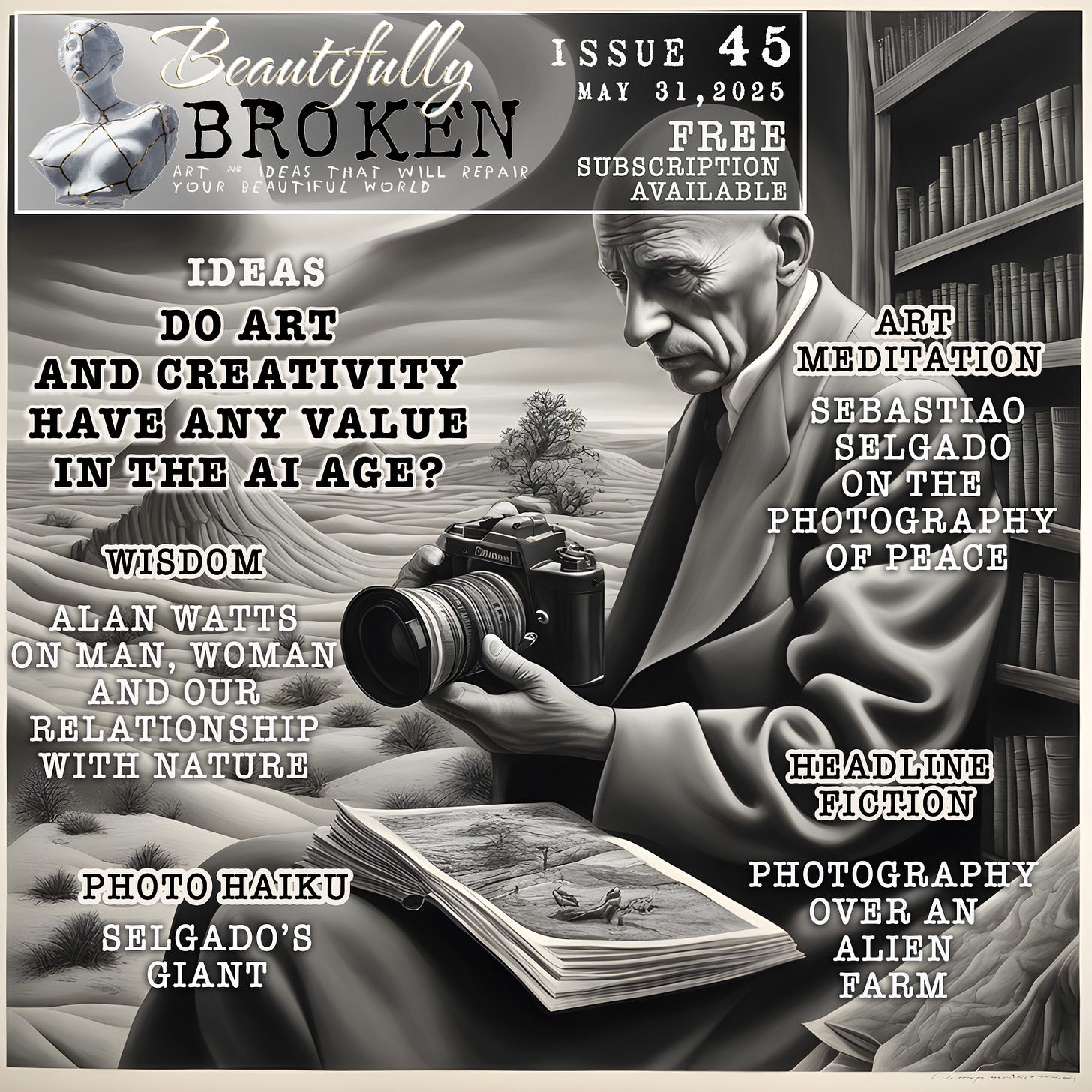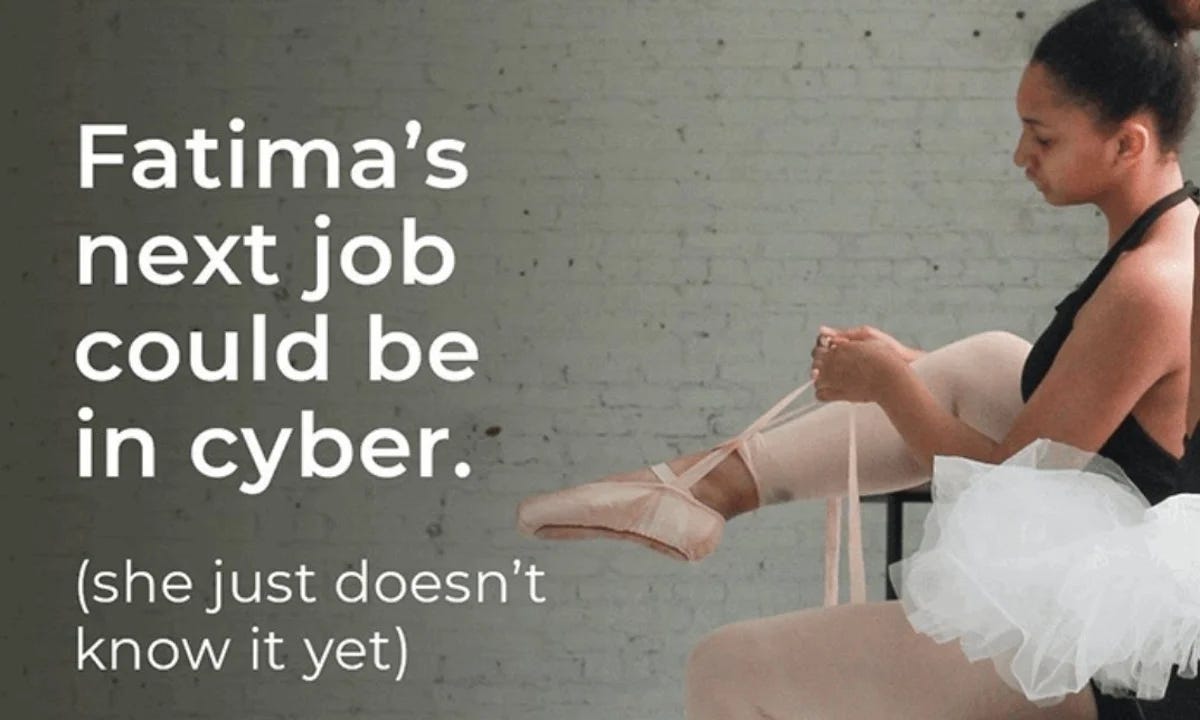Beautifully Broken Issue #45: The Value Of Art & Creativity In The Age of AI
IDEAS, ART & WISDOM TO REPAIR OUR BEAUTIFUL WORLD
Welcome to Beautifully Broken Issue #45: The Value Of Art & Creativity In The Age of AI
Editorial :
Will there continue to be career artists, writers and thinkers who can earn a living from their work or will we revert to the days where only the rich and privileged are permitted to express themselves artistically because anyone else with a creative streak will be too busy struggling to survive ?
During the pandemic, the UK government came under fire for a poster suggesting that a ballerina named Fatima should retrain in IT. The implication was that ballet was an indulgence, especially for someone from a non-privileged background, and that those people should get on and get a proper job as times were about to get tough. The French government, on the other hand, poured money into the arts at that time to sustain artists during a period where they couldn’t perform, knowing that after the pandemic the population would still want their creatives to add value to French life. The French knew that if a large number of creatives left to retrain in other fields that they’d not only lose a generation of performers but also a generation of teachers (as performers go on to train the next generation), which could potentially threaten the entire survival of arts in their nation. The British attitude was “fuck them, throw them under the bus, they were probably on welfare anyway.” The two different perceptions of the value of art and artists couldn’t be more opposite. How can two neighboring first world countries see art so differently? Let’s get into the nature of art, why it’s important, what the arts really are versus what we’ve been raised to believe and how the arts can heal us and the world.
Note on Sunrise Photo Haikus: I’ve been posting daily sunrise haikus for those who are interested but I haven’t worked out how to post it to the Beautifully Broken publication via my phone app (the only convenient way to do it) so I’ve been posting it to the “notes” section of my personal “Morgan Buchanan” page on Substack. You can click here to find them.
IDEAS: The Value Of Art & Creativity In The Age of AI
With the widespread availability of AI tools, it’s now possible to enter in a prompt like: “Write me a Stephen King style novel where I am the main character and my cat Charles is a supernatural monster” and the AI can knock out a pretty passable story. Or “Give me a painting that Dali might compose but using the elements of my life drawn from the personal photos I’ve attached”. And again, you’ll get something interesting. Hitting the button again means the AI tries to regenerate the request a different way, so you’ll get a slightly different story or painting. With this kind of “fast food” art and literature, why bother writing or painting anything yourself? Isn’t the AI only going to get better and better? Will we need artists, musicians, poets and authors at all?
What is art ?
Art is not the end result that we, the audience admire and judge, art is the process itself. The fact that the work is sometimes presented in real time (for example in a live concert), sometimes in frozen time (as in a recording or novel), the art is as much the creative moment as it is the transmission and reception of it by the audience. There are three forces at play—the creator in the moment, the receivers of what is being created and the work itself (music, words, images). A process like AI-generated art (which I use for my covers), allows me to transmit a visual message but it’s missing some vital elements —the energy of the creative process, the ability of the artist to transmit their art from the non-logical part of their being (deep mind, intuition, instinct) as opposed to the logical mind that calculates and writes a prompt designed to get a specific outcome, and the transmission of that energy to the unconscious and waking minds of the audience. It really is the difference between eating McDonald’s and eating a real meal, in terms of satisfaction, nutrition and connection. AI is, obviously, inhuman. A machine trying to guess what a human is and the more we ingest its output, the less human we become.
One way of coming to a definition of what art is, is to describe what it is not. Art, I’d like to propose, is the opposite of propaganda.
prop·a·gan·da | ˌpräpəˈɡandə |
noun
1 information, especially of a biased or misleading nature, used to promote or publicize a particular political cause or point of view: he was charged with distributing enemy propaganda.
• the dissemination of propaganda as a political strategy: the party's leaders believed that a long period of education and propaganda would be necessary.
Every form of expression that’s not art is trying to convince us of something, twist us to someone else’s position for their own benefit.
Art, on the other hand, is one human sharing their deepest experience and insight for the benefit of another. Even the world’s most self-absorbed writer, painter, musician or poet creates their work for someone other than themselves. To reveal something inside themselves that they feel the urge to share.
Put aside Picasso, Hemingway, ballet dancers and opera, and let’s consider horror writer Stephen King. A story by King is art because it comes from an honest place—his subconscious mind. His writing exposes our fears and desires and holds them up to the light. What is inside of us needs to be expressed truthfully in order for healing (catharsis) to take place.
Gold is valued primarily because it is hard to obtain in quantity and expresses qualities that we associate with the sun—golden, shining, brilliant. Silver is likewise valued because of its associations with the moon.
And what is so precious about the sun and moon that even a symbolic representation of them in mineral form is seen to be valuable?
The sun and the moon are symbols of eternity. They are powerful cyclical systems that regulate our lives. They are true, consistent, ever-present physical symbols that reflect an invisible reality that lies beneath our sensory perception. Those invisible forces also seek expression, also wish to exert their influence on our lives. When we repress them and impose a conscious, unyielding structure in which they have no avenue to vent their expression, they become twisted, dangerous or make us ill. Art, be it dance, singing, painting, writing, whatever, is the means to release and channel those hidden currents for positive benefit, so that they don’t become a tsunami. Throught them, we heal ourselves and the world—catharsis is achieved.
ca·thar·sis | kəˈTHärsəs |
noun (plural catharses | -sēz | )
1 the process of releasing, and thereby providing relief from, strong or repressed emotions: music is a means of catharsis for them.
ORIGIN
early 19th century (in catharsis (sense 2)): from Greek katharsis, from kathairein ‘cleanse’, from katharos ‘pure’. The notion of ‘release’ through drama (catharsis (sense 1) derives from Aristotle's Poetics.
Aristotle understood that the purpose of art was connected to the idea of healing.
Keep reading with a 7-day free trial
Subscribe to Beautifully Broken to keep reading this post and get 7 days of free access to the full post archives.





